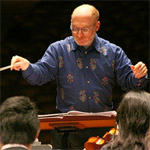New York Philharmonic Wind Band premiere postponed
 Aaron Jay Kernis
Aaron Jay Kernis
The original premiere of A Voice, a Messenger by Aaron Jay Kernis was postponed last season to this February but unfortnately New York was hit by heavy snow. The orchestra announced that due to the inclement weather, the New York Philharmonic on was forced to postpone the three-night engagement of Aaron Jay Kernis's A Voice, a Messenger yet again. The Philharmonic said it hopes to reschedule the performance in the future.
By CORINNA DA FONSECA-WOLLHEIM
For six days, the Israelites had circled the city in silence, led by their priests bearing the Ark of the Covenant. Only the sound of the shofar, the curved ram's horn, rang out across the walls, instilling terror in the hearts of the besieged. On the seventh day, after the seventh tour of the walls, the priests blew a single long note on the shofar, the sign for the Israelites to let out a thunderous roar. The walls collapsed; Jericho was theirs for the sacking.
Not only people but nature itself seems to take note whenever the trumpet and its curvier cousin, the shofar, make their appearances in the Bible. No wonder, then, that composers seeking to bring a note of awe to their music have always found the trumpet to be a natural ally - just try to imagine Bach's "Christmas Oratorio" without its gleaming, jubilant trumpets or Handel's "Messiah" without the rousing wake-up call of "The Trumpet Shall Sound."
A very different sort of trumpet will take center stage for three nights beginning Tuesday at the New York Philharmonic when Philip Smith, the orchestra's principal trumpeter, premieres "A Voice, a Messenger" by Aaron Jay Kernis as part of the program "Alan Gilbert and Soloists from the Philharmonic." And yet the work's roots reach all the way back to Jericho. (The concerto is a co-commission of the New York Philharmonic and the Big Ten Band Directors Association.) Mr. Smith, a devout Christian, requested that Mr. Kernis - a Jewish composer whose past works have included Holocaust references and texts by the medieval Spanish mystic Solomon Ibn Gabirol - base the piece on trumpet references in the Bible.
The New York Philharmonic has championed Mr. Kernis's music since 1983, when the composer was only 23 years old. "It had something that appealed to me," Mr. Smith says. "It was music that reflected his faith."
For inspiration, the trumpeter gave Mr. Kernis reams of biblical passages and commentary. "That made it all the more confusing," Mr. Kernis says. "What crystallized it for me was when I attended services on the first night of Rosh Hashana two years ago and there heard the shofar: that put everything in context."
Instead of bringing to life a specific biblical episode or evoking the Apocalypse ("Messiaen already did that"), his four-movement work took on the reflective, searching character of the Jewish Days of Awe. "It's more of an inner drama," Mr. Kernis says. "There is a sense of facing doubt as one does on the High Holidays, as one looks back on the year and remembers." In the work's fourth and final movement, he says, "the sound of the trumpet causes fear, as if something unwelcome is imminent."
"I don't think Aaron was specifically saying, 'This is a movement of war, this is a moment in the camp,'" Mr. Smith says. "But it sounds like he reflected on those [ideas] and came up with a story of his own. The first movement is very reflective. It builds intensely. You feel as if you're sharing your inner heart with the Lord. The second movement is a dance, a celebration. The third movement, played on the flugelhorn, is a very mellow Night Prayer, less pleading, to my mind, more calm. The finale sounds the most as if something is being said: If the two prayer movements are like talking to God, the last one is as if God is talking back."
That final movement also contains the most overt references to the different kinds of shofar blasts that are called for on Rosh Hashana: tekiah, a single long blast; shevarim, three short notes; teruah, nine quick blasts in rapid succession; and tekiah gadolah, one very loud and sustained note that functions as a call to battle in the Bible. Although Mr. Kernis decided not to feature an actual shofar in the work-Mr. Smith owns one and knows how to play it-he says the ram's-horn calls are "transformed" in the concerto, and relate to the techniques used. He also came across a reference to Rosh Hashana services during the time of the Second Temple, when the shofar would be flanked by two silver trumpets. The work's conclusion will have two trumpeters stand up and join Mr. Smith at the front of the stage.
For Mr. Smith, it is a perfect union of faith and art. As it is, he takes pride in playing an instrument that features so prominently in the Bible-"an instrument of power," as he calls it. His favorite trumpet-related Bible verse is from Corinthians, and an apt motto for a section leader in the New York Philharmonic: "If the trumpet give an uncertain sound, who shall prepare himself for the battle?"